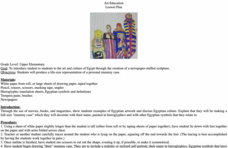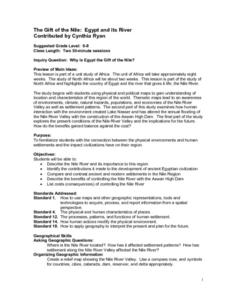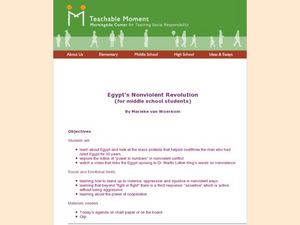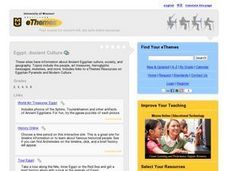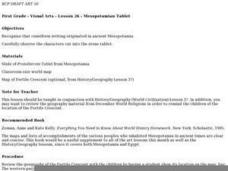Describing Egypt
Temple of Isis (Philae)
How did the Temple of Isis change throughout history? The resource discusses how architecture changed purposes over the time periods of the Pharaonic Era and the Greco-Roman Era. It gives a glimpse into what life was like and provides...
Facts and Files
The Nile
While it may not be possible to take an entire class to Egypt and explore the ancient wonders, it is possible to engage your young historians in activities that ask them to research these and other antiquities and place them on their...
Annenberg Foundation
Teaching Geography: Workshop 4—North Africa/Southwest Asia
Can Jerusalem be equitably organized? Can Israel and Palestine be successfully partitioned? Part one of a two-part workshop looks at the geo-political history of Jerusalem while Part two investigates Egypt's dependence of the Nile River...
Describing Egypt
Horemheb - (18th Dynasty)
Who was Horemheb and why is his tomb so famous? An fascinating resource uses virtual reality tools and even comes equipped with the ability to use a VR headset. Learners view information panels to the side of the location to understand...
Describing Egypt
Ptah-Hotep and Akhet-Hotep Mastaba
Did you know that mastaba means bench in Arabic? Learn why a mastaba was so important to ancient Egyptian architecture. Middle and high schoolers alike stay entertained while reading a passage that describes the virtual tour of...
University of California
Hellenistic Culture
It doesn't take long to change the world! Alexander the Great's reign may have been short-lived, but his vision for a multi-cultural Hellenistic world shaped Afroeurasia for centuries. Pupils examine documents, such as excerpts from...
Big Kid Science
Eclipse Classroom Activities: Cultural Significance Project
What better way to celebrate eclipses than across cultures? Explore myths of solar and lunar eclipses from ancient cultures like the Chinese, Ancient Greek, Mesoamerican, Incan, Egyptian, Ancient Babylonian, and Middle Eastern. Learners...
Crabtree Publishing
The Genius of the Ancients
It is said that necessity is the mother of invention. Fifth graders prove this with help from three lessons that examine how ancient cultures used their needs to drive innovations. In lesson one, pupils identify main ideas and supporting...
Syracuse University
Ancient World Writing System
Most twenty-first century pupils don't know how to interpret cuneiform. Examining images of cuneiform and papyrus writing and using a chart and Venn diagram, young historians extrapolate what life may have been like for people who lived...
Curated OER
Egyptian Mummy Cases
Here is an activity I'd like to do with my class! They researching the ins and outs of Egyptian culture, hieroglyphs, symbolism, and art, then use what they know to create realistic or stylized Mummy cases. These cases need to include...
Curated OER
A Journey into Tutankhamen's Tomb
Take a journey through time and space, as your class examines the contents found in King Tut's tomb. An image-rich presentation depicting the interior of the tomb, Howard Carter's finds, and the mummy of the king himself. The last slide...
Curated OER
Understanding Mayan Culture
Students study an ancient culture in Mexico whose people were called the Mayans. They compare certain aspects of Mayan culture with Ancient Egypt. They discuss why some other ancient cultures (Egypt and China) were able to survive for...
Curated OER
The Gift of the Nile: Egypt and its River
Students begin with a piece of a puzzle that shows an artifact from ancient Egypt. They find others who have pieces that go with their puzzle piece. Students work in these groups to construct a relief map of the Nile River Valley.
Curated OER
Egypt's Nonviolent Revolution
Students explore the nonviolent protests of the Egyptians. In this current events lesson, students watch a video and read articles about the 2011 Egyptian uprising. Students compare the Egyptian protest to the protests of the...
Curated OER
Ancient Greece: Athens as a City State
Sixth graders find Greece on the map and recognize how the geography of Greece was important in its development. In this ancient Greece lesson, 6th graders research Greece and compare to the civilization of ancient Egypt. Students answer...
Curated OER
Daily Life in Ancient Egypt
Students explain how artwork can inform about a culture and its traditions. They pretend to be archaeologists who have just opened a tomb. They interpret the past based on what they discover.
Curated OER
Egypt: Ancient Culture
Students access a variety of Internet resources regarding Ancient Egyptian culture, society, and geography. They view photos and timelines, take a virtual tour of the Nile, play interactive games,and watch video clips about modern Egypt.
Curated OER
Who Built the Pyramids?
Young scholars examine the two theories on how the pyramids at Giza were built. They watch a video on pyramids, take notes, and write a five-paragraph essay on how they think the pyramids were constructed.
Curated OER
Comparing and Contrasting Ancient Civilizations
Young scholars research the ancient civilizations of Rome, India, Greece, and Egypt. They conduct Internet research, compare/contrast aspects of each culture, and create a Powerpoint presentation.
Curated OER
Mesopotamian Tablet, Egyptian Art
First graders examine cuneiform writing from a stone tablet, then write a simple sentence using pictographs. They analyze various examples of Egyptian art, construct a model of an Egyptian boat, and create a class painting using glyphs...
Curated OER
Egyptian Enterprises
Students prepare a cultural exhibit on Egyptian history, culture, sites, monuments, and hieroglyphics using such media as posters, computer presentations, puppet shows, short plays, videotapes, museum exhibit panels, brochures and scale...
Curated OER
Unscramble the Words: Mummies
For this mummy word unscramble worksheet, students examine ten words pertaining to mummies. Students unscramble the words. There is no word bank.
Curated OER
Mummies: Tales from the Egyptian Crypts Part III
Students explore the world of the ancient Egyptians through the discovery of the Rosetta stone, the ancient tablet that unlocked the meaning of the hieroglyphs for modern scholars.
Curated OER
The Nile
Students recognize the Nile River played an important role in the lives of ancient Egyptians and still does today. They prepare a newspaper written in English and produced with advanced technology centered around researched information.
Other popular searches
- Ancient Egypt Worksheets
- Ancient Egyptian
- Ancient Egypt Pyramids
- Ancient Egyptian Art
- Mummification Ancient Egypt
- Ancient Egypt Geography
- Ancient Egypt Government
- Ancient Egyptian Boat
- Science in Ancient Egypt
- Geography of Ancient Egypt
- Ancient Egypt Lesson Plans
- Ancient Egypt Mummy











